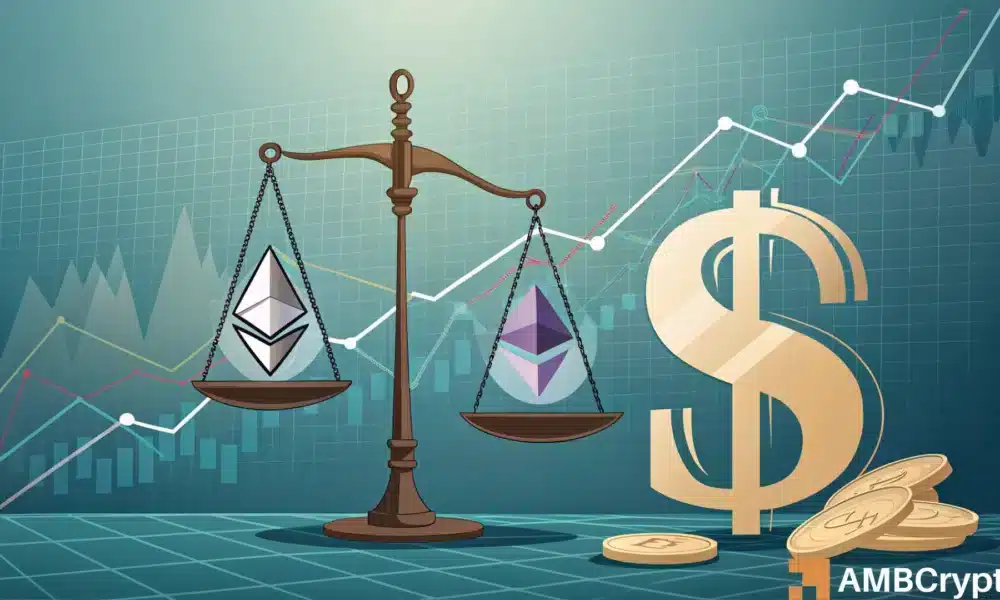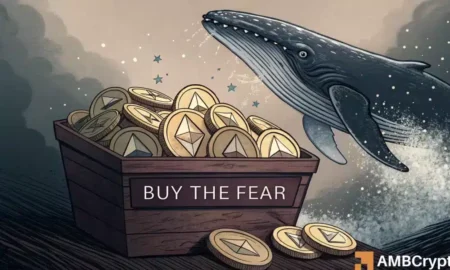Ethereum’s Q1 2025 Performance: A Closer Look at Fees, Investor Sentiment, and Future Outlook
In the first quarter of 2025, Ethereum’s decentralized applications (DApps) generated a staggering $1.01 billion in fees, highlighting the robust nature of its ecosystem. This figure showcases the continued demand for Ethereum’s blockchain technology, particularly as a platform for decentralized finance (DeFi) and non-fungible tokens (NFTs). However, beneath this remarkable success lies a troubling narrative: Ethereum’s native cryptocurrency, ETH, experienced a significant decline in value, with a drop of 41.63% from January to April. This disconnect raises important questions about the future of ETH as an investment and what it means for the overall health of the Ethereum network.
Despite the significant revenue generated from DApps, Ethereum has struggled to maintain its market position. The first quarter of 2025 saw Bitcoin and traditional assets like the S&P 500 outperform ETH, creating a scenario where strong network utility starkly contrasts with poor capital asset performance. Investors may be drawn to the high fees generated by DApps but remain hesitant about ETH’s long-term viability as an asset. This sentiment shift could indicate growing concerns among investors regarding Ethereum’s position in the market, potentially impacting future investment decisions and overall confidence in the network.
Further complicating Ethereum’s outlook is the notable decline in both whale and retail activity within the network. Data indicates that the number of addresses holding more than 10,000 ETH has decreased by nearly 10% since mid-February, signaling a retreat from large holders who may have lost faith in ETH’s potential for growth. Coupled with this exodus, daily active addresses on the network have steadily declined throughout March and into April, dipping to around 205,000. This dilution of interest among both institutional and retail investors points to a broader capitulation, suggesting that many are reassessing their positions in the Ethereum ecosystem amid increasing uncertainty.
As of now, ETH’s market price is reflecting these internal challenges. Trading at approximately $1,513, Ethereum’s value has seen a continuous downtrend, with significant selling pressure driving it further into oversold territory. Technical indicators such as the RSI (Relative Strength Index) and MACD (Moving Average Convergence Divergence) signal an ongoing bearish momentum, with little indication of an imminent recovery. If ETH fails to secure support above a critical level of $1,480, analysts anticipate potential declines to the next psychological floor around $1,300, which might spur further investor concern.
The decline in both whale and retail activity, combined with Ethereum’s price struggles, paints a concerning picture as the network heads into Q2 2025. While the DApp ecosystem thrives, creating a billion-dollar environment within just three months, the underlying challenges facing ETH might indicate greater systemic issues. Investor sentiment seems to be shifting, and without substantial changes in market perceptions or ETH’s price performance, the risk of further withdrawal from the network could grow.
In conclusion, while Ethereum’s DApps signify a strong backbone for network utility, the significant decline in ETH’s market value, coupled with drops in whale and retail participation, poses daunting challenges for the platform’s future. As the crypto market landscape evolves, Ethereum’s ability to maintain investor confidence and curate a sustainable growth model will determine whether it can regain its standing as a favored investment. For now, all eyes remain fixed on Ethereum’s ability to navigate this turbulent period and the implications of shifting sentiments within its user base.
















